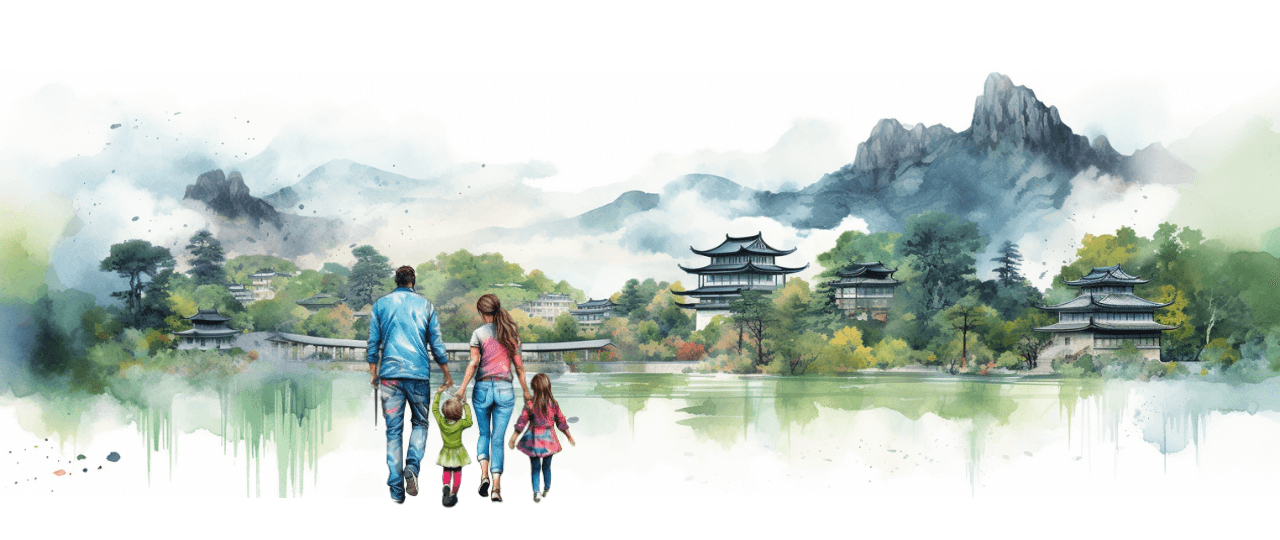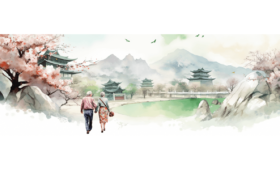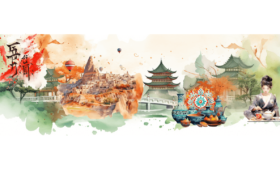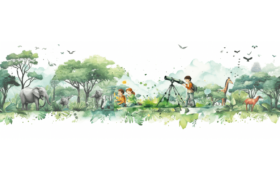Going on a journey through Asia’s historical sites for children is like stepping into a vibrant tapestry of cultures, legends, and architectural wonders. For families seeking an enriching and educational experience, this continent offers an unparalleled array of historical sites ideally suited for children’s curiosity and learning. This guide delves into Asia’s most captivating historical sites, each a gateway to the rich tapestry of stories, events, and people that have shaped this diverse and fascinating part of the world. Whether it’s marveling at the majestic Great Wall of China, experiencing the awe-inspiring beauty of India’s Taj Mahal, or uncovering the ancient mysteries of Cambodia’s Angkor Wat, these historical sites in Asia are not just travel destinations; they’re vibrant classrooms without walls, offering unique learning experiences for children. Join us as we explore these treasures, tailor-made for young explorers eager to learn and experience the wonders of Asia’s past.
The Great Wall of China- Mutianyu Section- China
The Great Wall of China, an iconic symbol of Chinese history and culture, stretches across vast landscapes. Among its various sections, the Mutianyu section stands out for its breathtaking scenery and relatively smaller crowds. Located approximately 70 kilometers northeast of Beijing, Mutianyu offers a unique blend of historical significance and natural beauty. This section, known for its well-preserved watchtowers and lush surroundings, dates back to the Ming Dynasty. It offers a more authentic experience compared to more tourist-heavy sections like Badaling.
Why Visit The Mutianyu Section of the Great Wall of China
Visiting the Mutianyu section of the Great Wall offers a chance to witness a piece of living history. The panoramic views of the surrounding hills and forests are stunning, especially during autumn when the foliage is a riot of colors.
For children, Mutianyu is a real-life history lesson combined with an adventure. The relatively gentle slopes and well-maintained paths make it safe and accessible for families. The excitement of walking along the ancient battlements and peering out from the watchtowers can ignite a child’s imagination about the past.
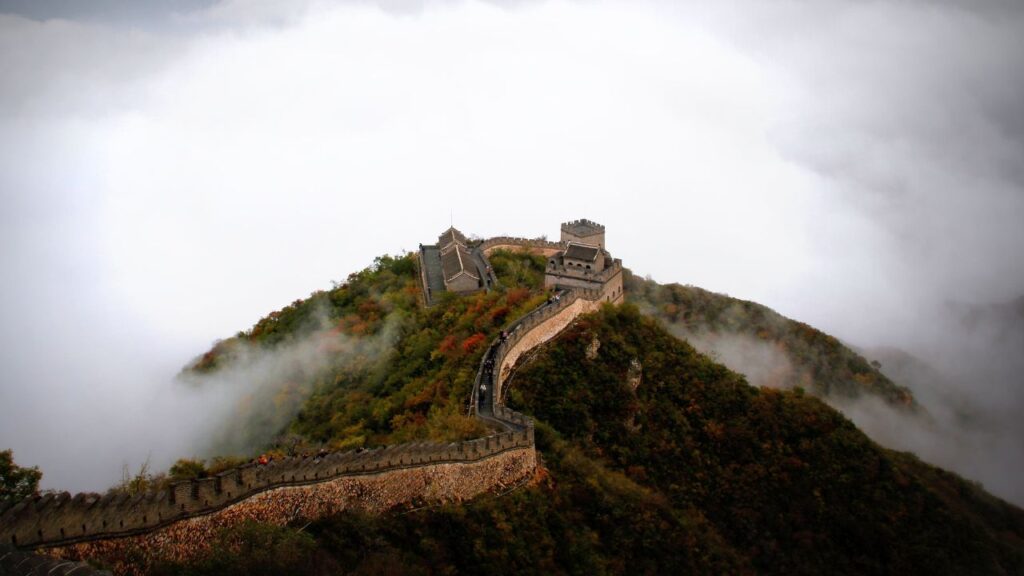
Best Time to Visit
The best time to visit the Mutianyu Great Wall is spring (April to June) and autumn (September to November). During these months, the weather is comfortable, and the scenery is at its most picturesque. Summer can be hot and crowded, while winter, though cold, offers its stark beauty and fewer tourists.
Traveler Tip
- Arrive early to avoid crowds and have more access to the wall.
- Wear comfortable shoes and bring water and snacks for energy, especially important for children.
- Consider hiring a guide for a more enriching experience with historical insights.
- Always check the weather before going and dress appropriately for mountain conditions.
Forbidden City- Beijing, China
The Forbidden City, located in the heart of Beijing, is a monumental historic site that served as the imperial palace for 24 emperors during the Ming and Qing dynasties. This vast complex spans 180 acres and consists of 980 buildings with over 8,000 rooms adorned with traditional Chinese architectural elements and deep cultural significance. It’s recognized as one of the most important cultural heritage sites in China and has been listed as a UNESCO World Heritage Site since 1987.
Why Visit with Children
Visiting the Forbidden City with children is a fantastic way to bring Chinese history to life. The sheer scale of the palace, the intricate designs, and the colorful stories behind each hall can captivate the imagination of young minds. It’s an educational journey through China’s imperial past, offering a tangible connection to the tales of emperors, court life, and ancient traditions. Interactive exhibits and child-friendly tours can make the experience even more engaging for younger visitors.
Best Time to Visit
The ideal time to visit the Forbidden City is during spring (April to May) and autumn (September to October). During these periods, the weather in Beijing is typically mild and pleasant, making outdoor exploration more comfortable. Summers can be hot and crowded, while winters are cold, though they offer the advantage of fewer tourists.
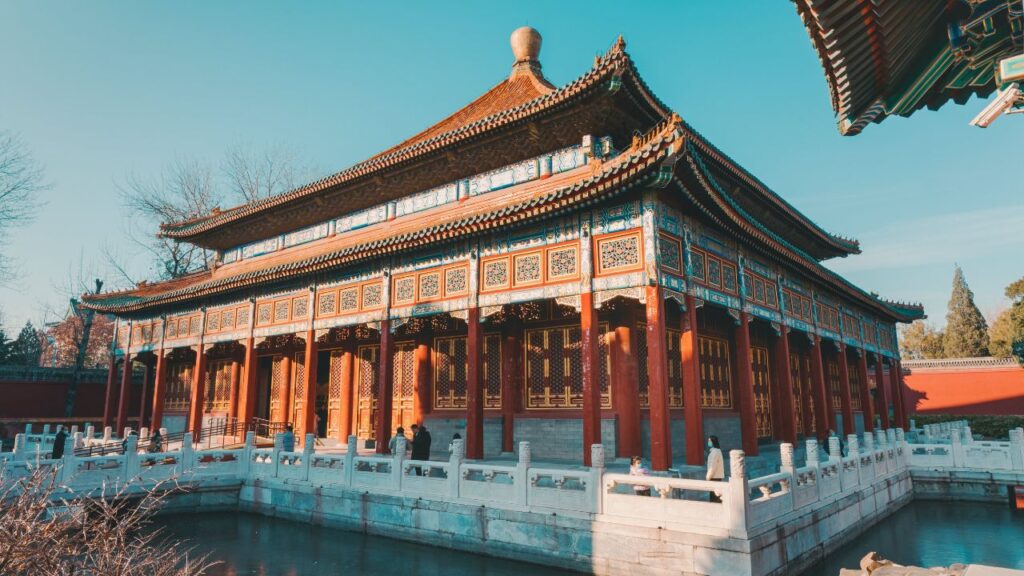
What to See
Key highlights within the Forbidden City include the Meridian Gate, the Hall of Supreme Harmony, the Hall of Central Harmony, the Hall of Preserving Harmony, and the Imperial Garden. Each of these areas has its own unique history and architectural features. Don’t miss the intricate details like dragon motifs, mythical creatures on rooftops, and beautifully painted beams that add to the grandeur of the palace.
Traveler Tip
- Plan ahead: to navigate the vastness of the Forbidden City effectively.
- Arrive early to avoid crowds, especially in peak tourist seasons.
- Use a guide or an audio guide for deeper historical and cultural insights.
Terra Cotta Warriors, Xi’an, China
The Terra Cotta Warriors, located near Xi’an in China’s Shaanxi province, are one of the most significant archaeological discoveries of the 20th century. This impressive collection of over 8,000 life-sized clay soldiers, along with chariots and horses, was discovered in 1974 and is believed to have been created to accompany the first Emperor of China, Qin Shi Huang, in the afterlife. The figures, dating back to around 210 BCE, are renowned for their detailed craftsmanship and historical value, showcasing the artistry and military of ancient China.
Why Visit with Children
Visiting the Terra Cotta Warriors is a fantastic educational experience for children. It offers a hands-on history lesson about ancient China, immersing them in the mysteries and wonders of the past. Seeing the warriors in person can spark a child’s interest in archaeology, history, and art. The site provides an excellent opportunity for children to learn about the concept of legacy, the beliefs of ancient peoples, and the detailed work of archaeologists.
Best Time to Visit
The best time to visit the Terra Cotta Warriors is spring (March to May) and autumn (September to November). During these months, the weather in Xi’an is mild and pleasant, making it ideal for exploring the site. Summers can be hot and crowded, while winters tend to be cold and less crowded.

What to See
The Terra Cotta Warriors are housed in three main pits, each offering a different view of the army. Pit 1, the largest, contains the main army; Pit 2 has a mix of military figures and chariots; and Pit 3 is thought to be the command center. Additionally, the Bronze Chariot Exhibition Hall displays two exquisite bronze chariots, and the on-site museum offers insightful background information.
Traveler Tips
- Plan your visit: To make the most of your visit,
- Bring Sun protection: Also, be prepared for the weather – bring sun protection for summer visits and dress warmly in winter.
- Mindfulness: Take your time to absorb the details of each figure, as each one is uniquely crafted with distinct facial expressions and attire.
Arashiyama- Kyoto, Japan
Arashiyama is a picturesque district on the western outskirts of Kyoto, Japan, known for its natural beauty and historical significance. Renowned for its bamboo grove, temples, and scenic views, Arashiyama offers a tranquil escape from the bustling city life. The area is steeped in history, with many temples and shrines dating back centuries, and is also famous for the Togetsukyo Bridge, which provides stunning views of the surrounding mountains.
Why Visit with Children
Arashiyama is an ideal destination for families with children. The area’s natural beauty and variety of attractions make it a perfect place for children to explore and learn. Walking through the bamboo grove can feel like stepping into another world, and the various temples and gardens offer a glimpse into Japanese culture and history. The district also has parks and open spaces where children can play and enjoy the outdoors.
Best Time to Visit
The best time to visit Arashiyama is during the spring (March to May) when the cherry blossoms are in bloom and in autumn (late November to early December) when the fall colors are at their peak. These seasons showcase the area’s natural beauty at its finest. However, these times can also be the busiest, so planning is advisable.
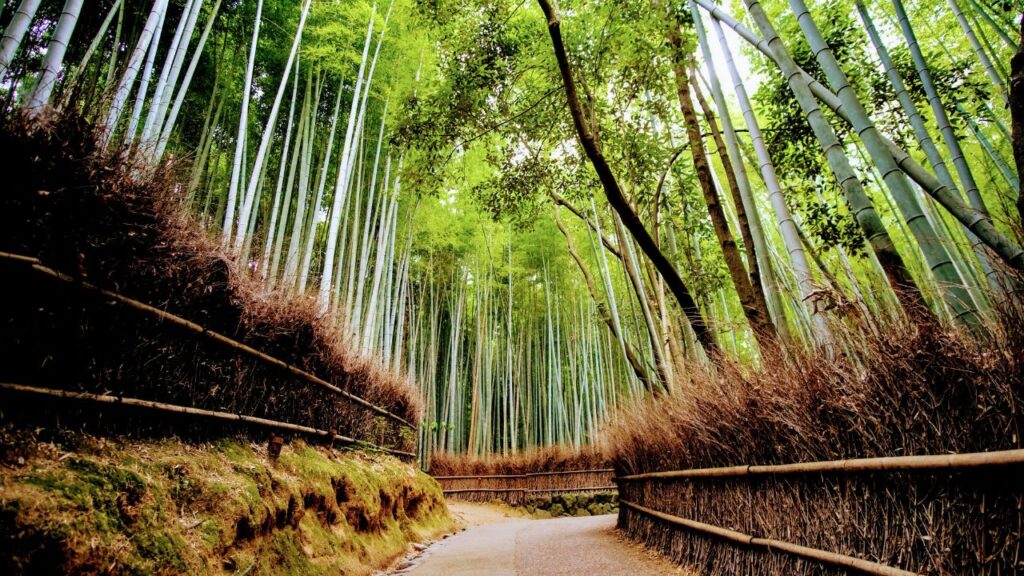
What to Expect
Visitors to Arashiyama can expect a range of experiences:
- Bamboo Grove: A walk through the towering bamboo is a must-do. The grove is otherworldly and provides a serene experience.
- Togetsukyo Bridge: Known for its views of the river and surrounding mountains, especially beautiful during cherry blossom and autumn color seasons.
- Temples and Shrines: Explore Tenryu-ji Temple, a UNESCO World Heritage site, and other smaller, charming temples scattered around the area.
- Iwatayama Monkey Park: Located on a small mountain, it’s home to a troop of friendly monkeys and offers great views of Kyoto.
Travel Tips
Plan Your Route: Decide in advance which attractions you want to see, as Arashiyama covers a large area.
Stay Hydrated: Bring water, especially during warmer months.
Use Public Transport: Arashiyama is easily accessible by train or bus from central Kyoto, making it a convenient day trip.
Be Mindful of Wildlife: At the Iwatayama Monkey Park, follow the rules for interacting with the monkeys for a safe and enjoyable experience.
Take a Boat Ride: For a different perspective, consider a boat ride on the Hozu River, particularly picturesque in spring and autumn.
Fushimi Inari Taisha, Kyoto- Japan
Fushimi Inari Taisha, located in Kyoto, Japan, is an iconic Shinto shrine known for its thousands of vibrant vermilion torii gates that trail up the forested mountain of Inari. This shrine, dedicated to Inari, the Shinto god of rice and prosperity, dates back to the 8th century and is one of the most famous and photographed sights in Kyoto. The shrine complex sprawls across the mountain and features numerous smaller shrines, tea houses, and stunning scenic views.
Reasons for Visiting with Children
Visiting Fushimi Inari Taisha with children can be a fascinating and fun experience. It’s an opportunity to introduce them to Japanese culture and the Shinto religion in an engaging and visually captivating environment. The hike through the Torii gates is an adventure, perfect for active families. Along the way, there are plenty of interesting statues, smaller shrines, and wildlife to keep children entertained. It’s also a great way to enjoy the outdoors and get some exercise as a family.

Best Time to Visit
The best time to visit Fushimi Inari Taisha is during the shoulder seasons of spring (March to May) and autumn (September to November). During these times, the weather is more comfortable for hiking, and the natural scenery is particularly beautiful, with cherry blossoms in spring and vibrant fall colors in autumn. The shrine is open 24 hours a day and can be very crowded during the day, so visiting early in the morning or later in the evening can offer a more peaceful experience.
What to See
- Torii Gates: The thousands of torii gates, or Senbon Torii (“thousands of torii gates”), are the main attraction, winding up the mountain.
- Sub-Shrines: Along the hike, there are many smaller sub-shrines where visitors can stop and explore.
- Fox Statues: Foxes are considered Inari’s messengers, and visitors will see many fox statues throughout the shrine.
- Summit of Mount Inari: For those who make the full hike, the summit offers a panoramic view of Kyoto.
Traveler Tips
- Pace Yourself: With young children, taking breaks and not rushing the experience is essential.
- Early Morning or Late Evening Visit: To avoid crowds and experience a more mystical atmosphere.
- Photography: While photography is allowed, be mindful not to obstruct pathways and be respectful of others taking photos.
- Check the Weather: The weather can change rapidly, so be prepared with rain gear or sun protection as needed.
Paro Taktsang- Buthan
Paro Taktsang, also known as the Tiger’s Nest Monastery, is one of Bhutan’s most revered and iconic landmarks. Perched on the side of a cliff 900 meters above the Paro Valley, this stunning monastery dates back to the 17th century. It is said to be the site where Guru Rinpoche, a significant figure in Bhutanese Buddhism, flew on the back of a tigress and meditated in a cave for three years, three months, three weeks, three days, and three hours. The monastery complex is a marvel of architectural and spiritual significance, offering breathtaking views and a serene atmosphere.
Reasons for Visiting with Children
Visiting Paro Taktsang with children can be an enriching experience. It introduces them to Bhutanese culture and Buddhism, and the hike to reach the monastery provides a great outdoor adventure. It’s an opportunity to teach kids about determination and the rewards of effort, as the hike is challenging but offers a sense of achievement once completed. The journey and the destination both provide incredible natural beauty and a chance to experience the peacefulness of the Bhutanese landscape.
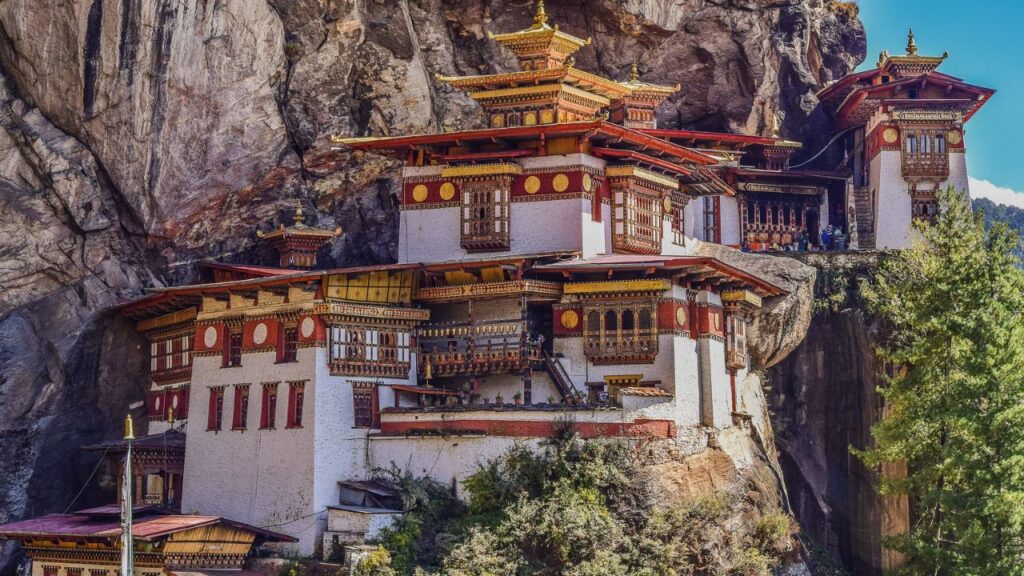
Best Time to Visit
The best time to visit Paro Taktsang is during the spring (March to May) and autumn (September to November). During these months, the weather is generally clear and mild, offering the best conditions for hiking and enjoying the views. The monsoon season (June to August) is less ideal due to rain and slippery trails, and winters can be quite cold.
What to See
- The Hike: The journey to the monastery is as memorable as the destination itself, featuring forested paths, prayer flags, and stunning vistas.
- The Monastery: Once at the monastery, visitors can explore the various temples and shrines within the complex.
- Cave of Taktshang Senge Samdup: The cave where Guru Rinpoche is said to have meditated.
- Viewpoints: There are several viewpoints along the hike, offering panoramic views of the monastery and the surrounding valley.
Traveler Tips
- Physical Preparedness: The hike to Paro Taktsang is steep and can be challenging, especially for children. Ensure everyone is physically prepared.
- Start Early: Beginning the hike early in the morning helps avoid crowds and the midday sun.
- Wear Appropriate Gear: Good hiking shoes and appropriate clothing are essential. The weather can change quickly, so bring layers.
- Respect the Culture: Bhutan is deeply traditional. Dress modestly and respect the local customs and religious sentiments.
- Photography: Photography inside the temples is usually not allowed, but you can capture the exterior and the journey.
- Altitude Awareness: Be mindful of the altitude and take it slow if anyone feels uneasy.
Gyeongbokgung Palace, South Korea
Gyeongbokgung Palace, located in Seoul, South Korea, is the largest of the Five Grand Palaces built during the Joseon Dynasty. Constructed in 1395, it served as the main royal palace for centuries. The palace is an exquisite example of traditional Korean architecture and a symbol of Korea’s rich history and cultural heritage. Despite being damaged and reconstructed several times throughout its history, including during the Japanese occupation, Gyeongbokgung remains a proud emblem of Korea’s resilience and architectural prowess.
Reasons for Visiting with Children
Gyeongbokgung Palace is a must-visit for anyone interested in Korean history and culture. The palace complex boasts striking structures such as Geunjeongjeon (the throne hall), Gyeonghoeru Pavilion, and Hyangwonjeong Pavilion, each with its unique history and architectural details. Visitors can witness the changing of the guard ceremony, which is a colorful, photogenic reenactment of a historical event. The palace also provides a serene and picturesque setting, with beautiful gardens and ponds, making it a perfect spot for leisurely walks.
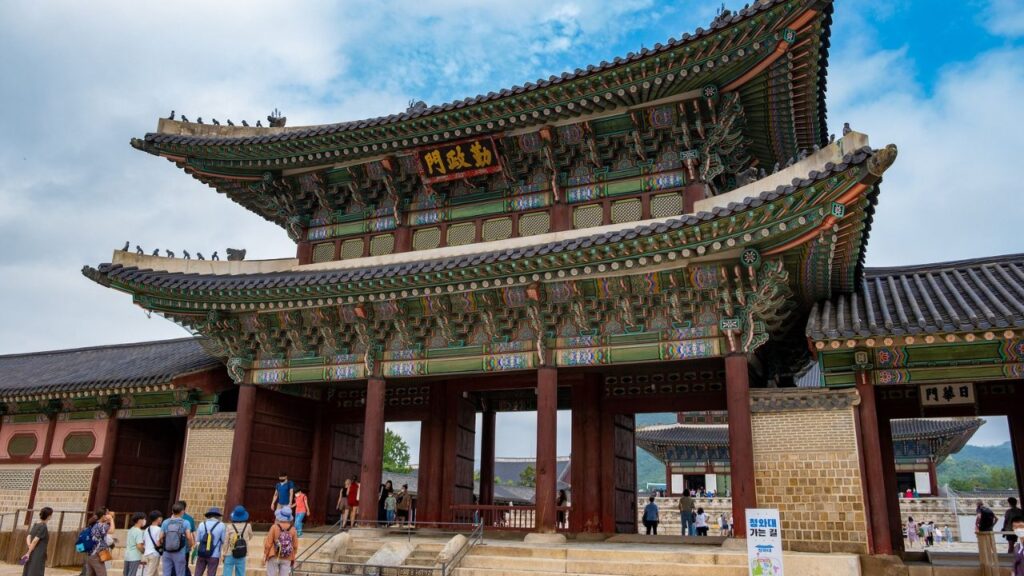
Best Time to Visit
The best time to visit Gyeongbokgung Palace is spring (April to June) and autumn (September to November). During these periods, the weather is pleasant, and the palace grounds are lovely, with the blooming of cherry blossoms in spring and the vibrant autumn foliage. Summers can be hot and humid, while winters are cold, but each season offers its unique charm to the palace scenery.
What to See
- Geunjeongjeon: The main throne hall, where significant royal events were held.
- Gyeonghoeru Pavilion: A stunning pavilion set on an island in a lake, used for banquets.
- Hyangwonjeong Pavilion: An iconic two-story hexagonal pavilion set in the middle of a tranquil pond.
- National Palace Museum of Korea and National Folk Museum: Located within the palace grounds, these museums offer insights into Korea’s royal history and traditional culture.
- Royal Guard Changing Ceremony: A reenactment of the royal guard’s changing ceremony, a colorful and photogenic event.
Traveler Tips
- Cultural Experience Programs: Look out for cultural programs or activities that often take place in the palace, like traditional craft-making or performances.
- Photography: While photography is allowed, be mindful of not obstructing others’ views, especially during the changing of the guard ceremony.
- Arrive Early: To avoid crowds and have a more peaceful experience, try to visit early in the morning.
- Palace Pass: If you plan to visit other palaces, consider getting a combination ticket that covers multiple sites.
Ta Prohm- Cambodia
Ta Prohm, one of the most atmospheric and enchanting temples in the Angkor Archaeological Park in Cambodia, offers a unique blend of natural and man-made wonders. Famous for its intertwined trees growing out of the ruins, Ta Prohm stands as it was found: swallowed by the jungle. Built in the late 12th and early 13th centuries as a Mahayana Buddhist monastery and university, it was originally called Rajavihara. The temple’s photogenic and atmospheric combination of trees growing out of the ruins and the jungle surroundings have made it one of Angkor’s most popular temples.
Reasons for Visiting with Children
Ta Prohm is an excellent destination for families with children due to its adventurous and mystical ambiance. Walking through these ruins can feel like stepping into a lost world or a movie set, sparking children’s imaginations. The sight of massive tree roots enveloping ancient stone structures creates a fairy-tale-like atmosphere that can engage kids in a way that few historical sites can. It’s also a great opportunity to educate children about the importance of preserving historical sites and the interplay between nature and human constructions.
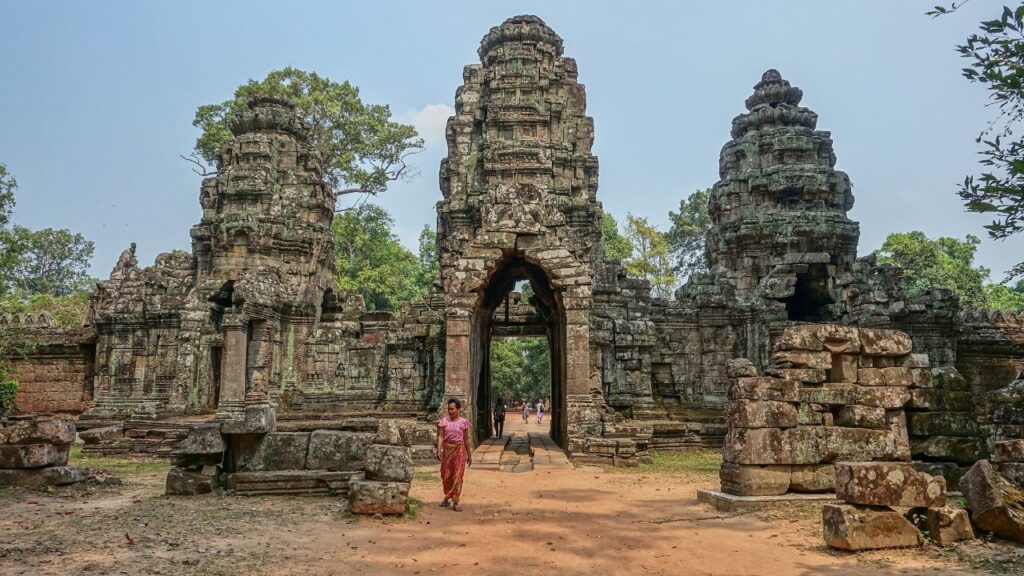
Best Time to Visit
The best time to visit Ta Prohm is during the cooler, drier season from November to February. The weather is more comfortable for exploring, and the light is often better for photography. Early morning is the best time to visit to avoid the crowds and the midday heat.
What to See
- Tree-Entwined Ruins: The most striking feature of Ta Prohm is the way the trees have merged with the stone structures, with roots and branches entwined among the ruins.
- The “Tomb Raider Tree”: One of the most famous spots in Ta Prohm, where scenes from the film “Tomb Raider” were shot.
- Hall of Dancers: Admire the intricate carvings and the serene atmosphere of this part of the temple.
- Carvings and Bas-Reliefs: The temple walls are adorned with detailed bas-reliefs, depicting various scenes and figures.
Traveler Tips
- Photography: Early morning offers the best light for photography and fewer crowds.
- Insect Repellent: The jungle setting means there can be mosquitoes, so insect repellent is advisable.
- Explore the Surroundings: Allocate time to explore the area surrounding the Angkor Archaeological Park, as there are many other impressive temples nearby.
Angkor Wat- Cambodia
Angkor Wat is a magnificent temple complex in Cambodia, renowned as the largest religious monument in the world. Originally built as a Hindu temple dedicated to the god Vishnu in the early 12th century by King Suryavarman II, it gradually transformed into a Buddhist temple towards the end of the 12th century. This iconic site, a symbol of Cambodia, appears on the national flag and is celebrated for its grandeur and exquisite artistry. The temple complex is known for its intricate bas-reliefs, majestic towers, and symmetrical design, set amidst a vast moat and lush greenery.
Reasons for Visiting with Children
Angkor Wat offers a unique educational and adventurous experience for children. Exploring this ancient temple can be like a journey back in time, sparking curiosity about history, archaeology, and different cultures. It’s an opportunity for children to witness the grandeur of ancient architecture and learn about the Hindu and Buddhist traditions that shape much of Southeast Asian culture. The sheer size and the maze-like layout of the temple can be a fun exploration for kids.

Best Time to Visit
The best time to visit Angkor Wat is during the dry season, from November to April. During this period, the weather is cooler and less humid, making it more comfortable to explore the expansive site. Early morning is an ideal time to visit, as it allows you to witness the stunning sunrise over the temple and avoid the heat and crowds that build up later in the day.
What to See
- Central Temple Complex: The central structure, with its iconic lotus-like towers, is a must-see.
- Bas-Reliefs: The walls of Angkor Wat are adorned with extensive and intricate bas-reliefs depicting various Hindu stories, including the Churning of the Ocean of Milk.
- Outer Gallery: The outer gallery features large-scale scenes from Hindu mythology.
- Banteay Srei: A nearby temple is known for its beautiful, deep, and intricate carvings in pink sandstone.
- Sunrise and Sunset Views: The temple is famous for its breathtaking sunrises and sunsets.
Traveler Tips
- Photography: Be mindful of the lighting for photography; early morning or late afternoon offers the best natural light.
- Crowd Avoidance: If you wish to avoid crowds, explore some of the less-visited temples within the Angkor complex.
Bagan, Myanmar
Bagan, located in the Mandalay Region of Myanmar, is one of the world’s greatest archaeological sites, comparable to Angkor Wat in Cambodia. This ancient city was the capital of the Pagan Kingdom from the 9th to 13th centuries, during which over 10,000 Buddhist temples, pagodas, and monasteries were constructed. Today, around 2,200 of these structures still stand, spread across a vast plain and creating a mystical and picturesque landscape. Bagan is not only a testament to the religious devotion of the Burmese but also a showcase of brilliant architectural styles and artwork.
Reasons for Visiting with Children
Visiting Bagan with children can be a magical and educational experience. The area is like an open-air museum, perfect for inspiring young minds about history and culture. Exploring the temples, each with its unique design and story, can be an adventure, sparking a child’s interest in archaeology and ancient civilizations. The relatively flat and open landscape of Bagan makes it easy for families to navigate and explore at their own pace.
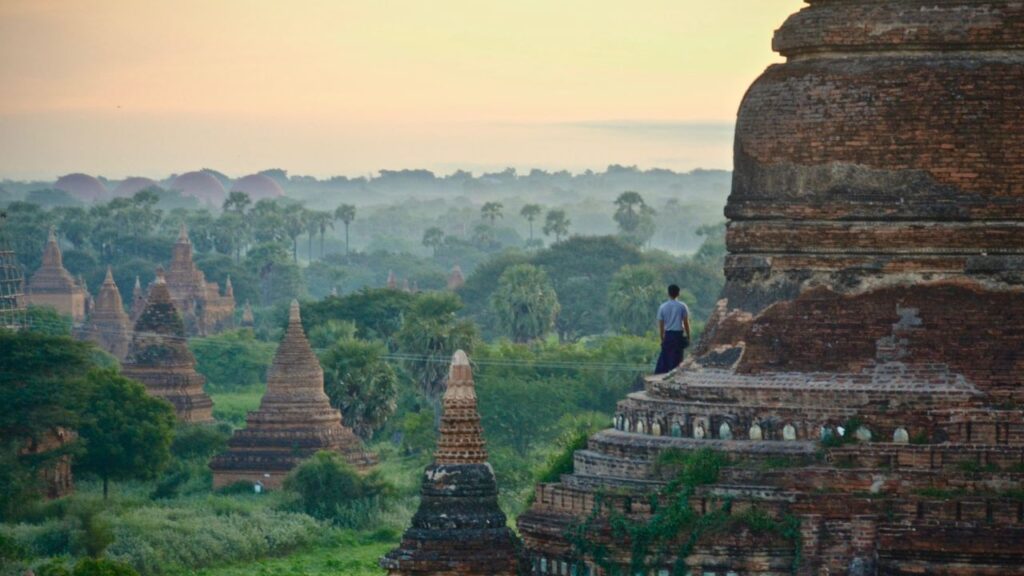
Best Time to Visit
The best time to visit Bagan is during the cooler, drier months from November to February. During this period, the weather is more comfortable for outdoor exploration. The monsoon season, from June to October, can make travel more challenging due to heavy rains and muddy conditions.
What to See
- Ananda Temple: Known as the ‘Westminster Abbey of Burma,’ this temple is one of Bagan’s most beautiful and revered.
- Dhammayangyi Temple: The largest temple in Bagan, noted for its distinct, pyramid-like shape.
- Shwezigon Pagoda: A stunning gold-leafed pagoda and an important pilgrimage site.
- Sunrise and Sunset Views: One of the highlights in Bagan is watching the sunrise or sunset over the plains, with silhouettes of temples creating a breathtaking view.
- Local Villages: Visiting nearby villages can provide insight into the local way of life and culture.
Things to do
- Hire a Bicycle or E-bike: This is a fun and efficient way to explore the temple plains.
- Hot Air Balloon Ride: For a unique view of Bagan, consider a hot air balloon ride, which, although pricey, offers an unforgettable experience of the landscape.
Traveler Tips
- Sun Protection: Use sunscreen and hats to protect from the sun, especially during the middle of the day.
- Be Mindful of Children: Keep an eye on children, especially in higher or more enclosed areas of the temples, for safety.
Borobudur Buddhist Temple- Indonesia
Borobudur is a magnificent Buddhist temple situated in Central Java, Indonesia. Renowned as the largest Buddhist monument in the world, this 9th-century Mahayana Buddhist temple is a masterpiece of both Buddhist architecture and Indonesian art. The structure is a massive step pyramid with nine platforms topped by a central dome. It is adorned with 2,672 relief panels and hundreds of Buddha statues. Borobudur is not just a temple but also a symbol of Indonesia’s rich cultural heritage, and it has been designated as a UNESCO World Heritage Site.
Reasons for Visiting
Borobudur is a must-visit for its historical and spiritual significance, as well as its architectural grandeur. The temple is a representation of Buddhist cosmology, symbolizing the path from the world of desire through the world of forms to the world of formlessness. Exploring Borobudur is like walking through a living history book, with each relief panel telling a story from Buddhist teachings. The site is not only a pilgrimage site for Buddhists but also a place of extraordinary beauty and tranquility.

Best Time to Visit
The ideal time to visit Borobudur is during the dry season, which runs from April to October. During this time, the weather is more favorable for exploring the temple. Early morning, around sunrise, is one of the best times to visit, as it not only avoids the heat of the day and the crowds but also offers a chance to witness the breathtaking sunrise over the temple.
What to See
- Relief Panels: The temple walls are covered in detailed relief panels depicting Buddhist teachings and stories.
- Stupas and Buddha Statues: The upper terraces are home to multiple stupas, each containing a statue of the Buddha.
- Central Dome: The large central dome is surrounded by 72 Buddha statues seated inside perforated stupas.
- Surrounding Scenery: Borobudur is set against a backdrop of lush green hills and distant volcanoes, offering spectacular views.
- Explore the Surroundings: The area around Borobudur, including nearby smaller temples and the lush Javanese countryside, is worth exploring.
Traveler Tips
- Arrive Early: To experience the temple in a more serene setting and to catch the sunrise.
- Sun Protection: Wear sunscreen and a hat to protect against the strong sun.
- Photography: Remember to be respectful when taking photos, especially of monks or worshippers.
Batu Caves, Malaysia
Batu Caves, located just north of Kuala Lumpur, Malaysia, is a 400-million-year-old limestone hill featuring a series of caves and cave temples. It’s one of the most popular Hindu shrines outside India, dedicated to Lord Murugan, a Hindu deity. The site is known for its massive golden statue of Murugan at the entrance and the colorful steps leading to the main caves. The natural and cultural heritage of Batu Caves makes it a fascinating destination for visitors of all ages.
Reasons Why Kids Love Visiting
Children are often captivated by the vibrant and lively atmosphere at Batu Caves. The giant statue of Lord Murugan and the brightly painted 272-step staircase to the Cave Temple are visually striking and engaging for young minds. The presence of friendly monkeys along the way adds an element of fun and excitement. Additionally, the exploration of the caves themselves can be an adventurous experience, sparking a sense of wonder and curiosity about nature and different cultures.
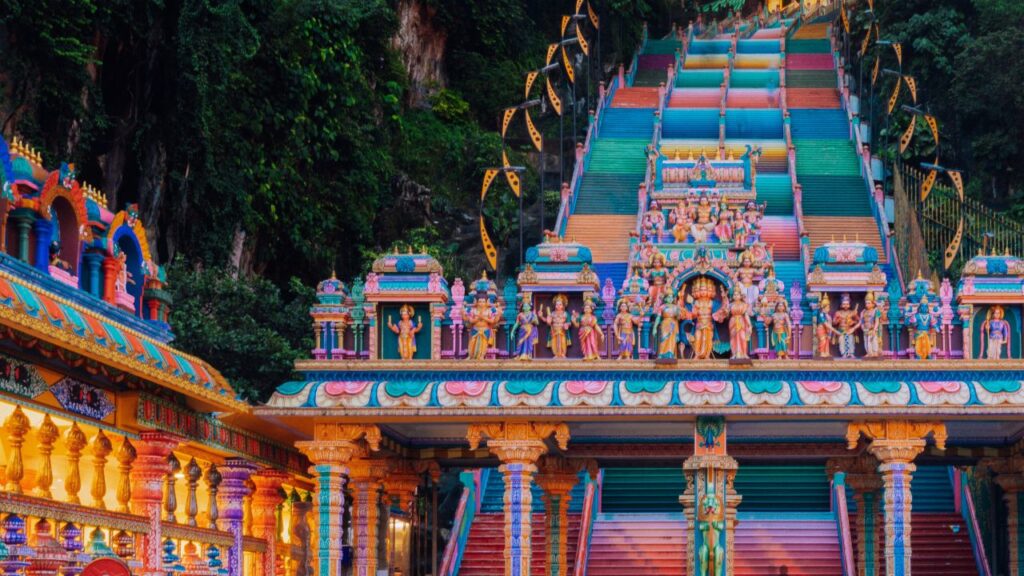
Best Time to Visit
The best time to visit Batu Caves is during the cooler, drier months from December to February. However, to experience the site at its most vibrant, consider visiting during the Thaipusam festival (usually in January or February). During this Hindu festival, Batu Caves becomes a hub of activity, with colorful processions and various cultural performances.
What to See and Things to Do
- Lord Murugan Statue: The world’s tallest statue of Lord Murugan, at 42.7 meters high, is a sight to behold.
- Cave Temples: The Cathedral Cave, the largest and most popular, contains several Hindu shrines beneath its high vaulted ceiling.
- Dark Cave: A conservation site home to a diverse range of cave fauna, including some rare species. Educational guided tours are available.
- Art Gallery Cave and Museum Cave: These caves at the foot of the hill feature Hindu statues and paintings.
- Climbing the Steps: Climbing the colorful steps to the Cave Temple is a physical but rewarding experience.
Traveler Tips
- Monkey Interactions: While the monkeys are a fun attraction, they are wild animals. Caution should be exercised, and it’s best not to feed them.
- Arrive Early: Avoid crowds and the heat, especially during festivals or weekends.
- Accessibility: The main Temple Cave is accessible only by stairs, which might be challenging for young children or those with mobility issues.
- Thaipusam Festival: If visiting during Thaipusam, be prepared for large crowds and a festive atmosphere, but also be mindful of the religious activities.
Chang Mai-Thailand
Chiang Mai, nestled in the mountainous region of Northern Thailand, is a city that blends rich history with modern Thai culture. Known as the “Rose of the North,” Chiang Mai is famous for its beautiful temples, lush landscapes, vibrant markets, and laid-back atmosphere compared to the bustling streets of Bangkok. The city is surrounded by mountains and lush countryside, with an old city area still encircled by ancient walls and moats.
Why Visit with Children
Chiang Mai is an excellent destination for families with children due to its diverse range of activities catering to all ages. The city offers a mix of cultural experiences, outdoor adventures, and educational opportunities. Children can enjoy interactive experiences like Thai cooking classes, visit elephant sanctuaries, or explore the city’s numerous temples. The city’s relatively small size and calm demeanor make it easier for families to navigate and explore.
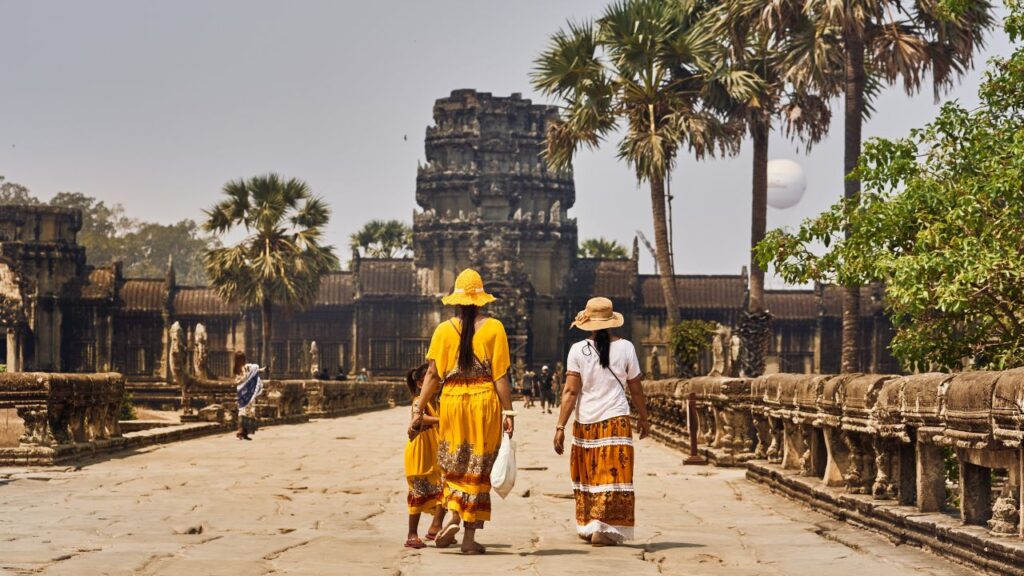
Best Time to Visit
The best time to visit Chiang Mai is from November to February, when the weather is cooler and dry. This period is ideal for outdoor activities and temple visits. The city also celebrates several festivals during these months, including the famous Lantern Festival (Yi Peng) and the Flower Festival, which are both visually spectacular and fun for kids.
What to Visit – Temples and More
- Wat Phra That Doi Suthep: This temple is one of the city’s most famous landmarks, located on a mountain overlooking Chiang Mai.
- Wat Chedi Luang: A historical temple in the heart of the Old City, known for its large chedi (pagoda).
- Wat Phra Singh: This temple houses an important Buddha statue and is a classic example of Northern Thai architecture.
- Elephant Nature Park: A sanctuary for elephants where families can learn about and interact with these majestic creatures.
- Doi Inthanon National Park: Known for its waterfalls, hiking trails, and the highest peak in Thailand.
- Night Bazaar: A bustling market where families can shop for souvenirs, try local foods, and experience the lively atmosphere.
Traveler Tips
- Local Cuisine: Try the local Northern Thai cuisine, which is different from other regions in Thailand.
- Transportation: Tuk-tuks and songthaews (red trucks) are convenient ways to get around, but agree on a price before starting your journey.
- Cultural Etiquette: Teach children about local customs and etiquette, like removing shoes before entering temples and being respectful of monks.
- Health Precautions: Use mosquito repellent and sunscreen, especially when engaging in outdoor activities.
- Festival Times: If visiting during festivals, book accommodations well in advance due to increased tourist traffic.
Petra- Jordan
Petra, often described as the “Rose City” due to the color of the stone out of which it is carved, is an archaeological site in Jordan famous for its rock-cut architecture and water conduit system. Once the thriving capital of the Nabataean Empire, Petra is now a UNESCO World Heritage Site and one of the New Seven Wonders of the World. This historical and archaeological city is renowned for its unique structures, including the iconic Treasury (Al-Khazneh) and the Monastery (Ad Deir).
Why Visit with Children
Visiting Petra can be a remarkable experience for children, offering a mix of education, adventure, and wonder. Exploring this ancient city can be like stepping into a real-life history book or a scene from an adventure movie (indeed, Petra is featured in Indiana Jones). The site is rich in history and storytelling, which can ignite a child’s imagination about ancient civilizations, archaeology, and exploration.
Best Time to Visit
The best time to visit Petra is during spring (March to May) or autumn (September to November). During these months, the weather is more pleasant, avoiding the summer’s intense heat and the winter’s cold. The site can get quite crowded, so visiting early in the morning or later in the afternoon can help avoid the largest crowds.
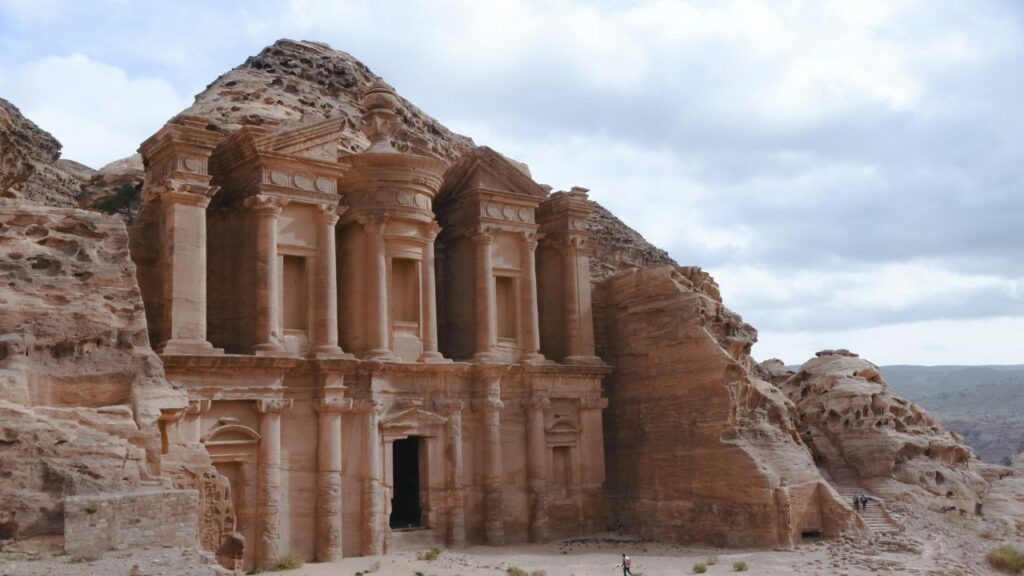
What You Will See and Do There
- The Siq: A narrow gorge, the main entrance to Petra, leading directly to the Treasury.
- The Treasury (Al-Khazneh): Petra’s most famous monument, an impressive facade carved out of the pink sandstone cliff.
- The Monastery (Ad Deir): A large structure similar to he Treasury but located high in the hills, offering spectacular views.
- Royal Tombs: A set of impressive tombs carved into the face of the mountain.
- Theatre: An ancient Nabataean theatre carved out of rock.
- Street of Facades and the Colonnaded Street: Lined with various structures, once the bustling center of Petra.
- Camel and Donkey Rides: These are available but ensure that the animals are well-treated before deciding to ride.
Tips for Visitors
- Guided Tours: Consider a guided tour to learn more about the history and significance of the site.
- Protection from the Elements: Wear sunscreen, a hat, and sunglasses. In the winter months, layers are recommended due to cooler temperatures, especially in the morning and evening.
- Photography: Early morning or late afternoon offers the best light for photography.
Taj Mahal, India
The Taj Mahal, located in Agra, India, is an iconic symbol of love and one of the world’s most renowned architectural marvels. Mughal Emperor Shah Jahan built this white marble mausoleum in memory of his beloved wife, Mumtaz Mahal, and it’s considered a masterpiece of Mughal architecture. The Taj Mahal is a UNESCO World Heritage Site and one of the New Seven Wonders of the World, attracting millions of visitors each year.
Reasons for Visiting with Children
A visit to the Taj Mahal can be a profoundly educational and inspiring experience for children. It offers them a glimpse into Indian history and culture, and the story behind the Taj Mahal provides a touching example of love and dedication. The sheer beauty and scale of the monument can captivate young minds, sparking interest in architecture, history, and art. The surrounding gardens and the Yamuna River add to the site’s peaceful and picturesque setting, making it enjoyable for a family outing.
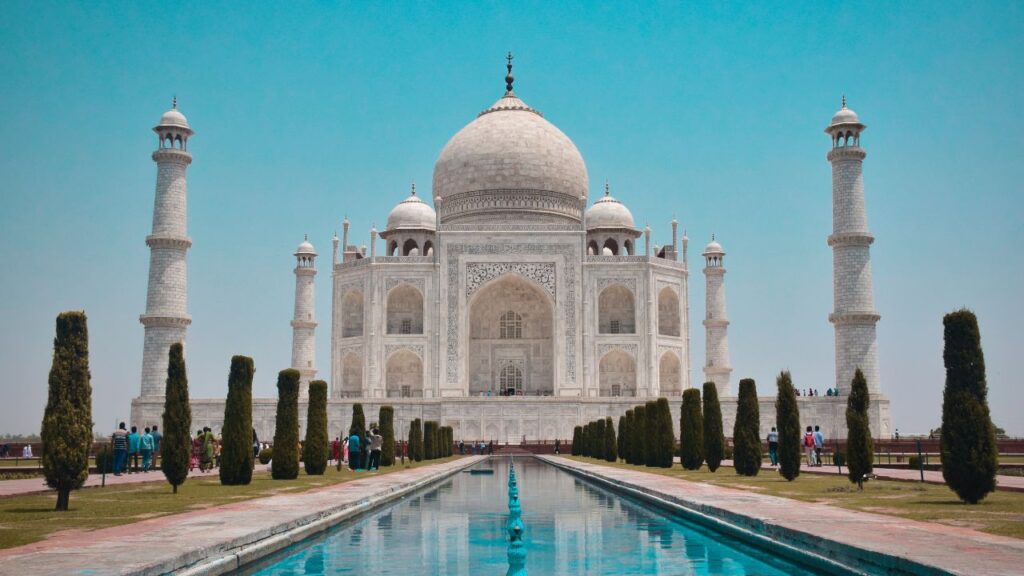
Best Time to Visit
The best time to visit the Taj Mahal is from November to March, when the weather is cooler and more comfortable for outdoor exploration. The monument can be crowded, so visiting early in the morning can help avoid the biggest crowds and experience a quieter, more serene atmosphere. The Taj Mahal is also incredibly beautiful at sunrise and sunset when the changing light reflects off the marble.
What to See and Expect
- The Main Mausoleum: The central focus of the complex, with intricate carvings and inlay work.
- The Four Minarets: Standing at each corner of the mausoleum’s plinth, adding to its majestic appearance.
- The Gardens: Beautifully laid out gardens that run along the central walkway to the mausoleum, providing a serene environment.
- The Reflecting Pool: Adding to the symmetry and beauty of the complex.
- Red Sandstone Mosques: Flanking the Taj Mahal adding to the architectural balance of the complex.
- The Yamuna River: Flowing behind the Taj Mahal, offering a peaceful backdrop.
Tips for Visitors
- Security and Restrictions: Security is tight, and certain items like food, tripods, and large bags are not allowed inside.
- Photography: Tripods and drones are prohibited, but photography is encouraged.
- Shoe Covers: Shoe covers are provided with the ticket and must be worn inside the mausoleum.
- Avoid Fridays: The Taj Mahal is closed to tourists on Fridays as it’s open for prayers.
- Beware of Scams: Be cautious of unofficial guides and vendors around the site.
Traveler Tips when visiting Historical Sites for Children in Asia
- Guided Tours: Consider a guided tour for a more informative experience in every destination in Asia when you travel with children
- Respect the Site: Everywhere you go, respect the site you visit.
- Water and Snacks: Carry plenty of water and some snacks, as exploring Historical Sites in Asia involves a lot of walking, often in hot and humid conditions.
- Comfortable Footwear: There’s a lot of walking on uneven terrain, so wear sturdy, comfortable shoes.
- Dress Appropriately
- Arrive Early: To avoid crowds, especially in the bamboo grove, try to arrive early in the morning. Some sites are also interesting at night.
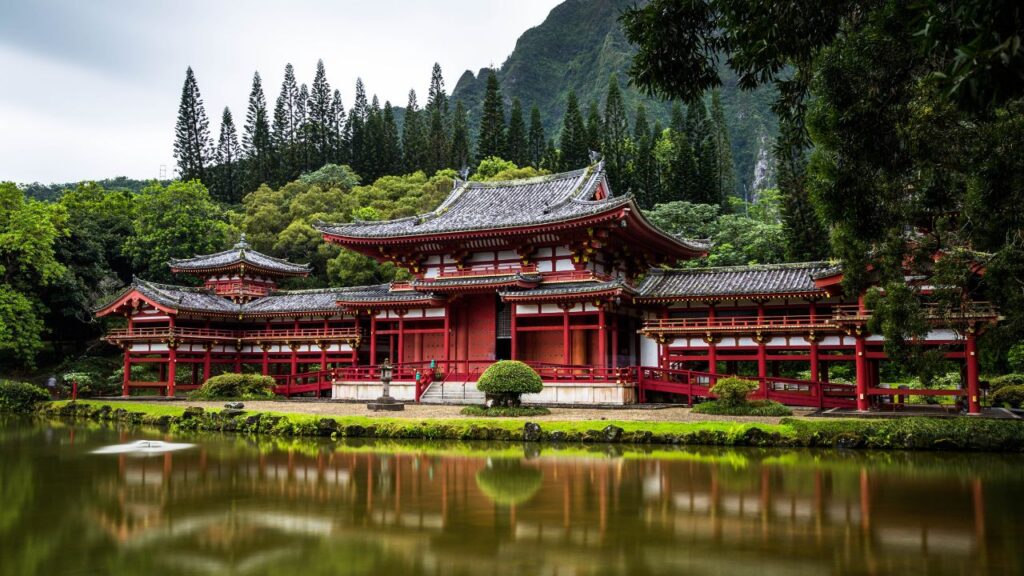
In conclusion, Asia is home to some of the world’s most captivating historical sites, offering enriching and educational experiences for children. From the Great Wall of China to the ancient temples of Cambodia, these destinations blend history with adventure, making learning fun and interactive. Parents can spark a lifelong interest in history and culture in their young explorers by choosing child-friendly sites like these. Visiting these iconic historical sites for children in Asia, you and your family will have a unique opportunity to create lasting memories while educating children about the rich heritage of Asia.
If you want to have more Adventure Holidays with Kids in Asia, read our guide and see all the amazing destinations worth visiting with kids.

